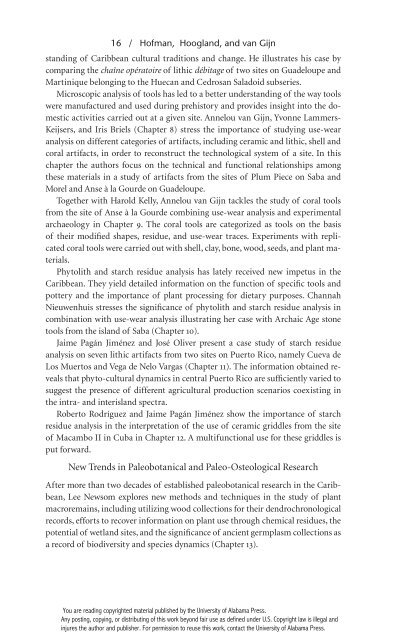Crossing the Borders: New Methods and Techniques in the Study of Archaeological Materials from the Caribbean
by Corrine L. Hoffman, et. al.
by Corrine L. Hoffman, et. al.
Create successful ePaper yourself
Turn your PDF publications into a flip-book with our unique Google optimized e-Paper software.
16 / H<strong>of</strong>man, Hoogl<strong>and</strong>, <strong>and</strong> van Gijn<br />
st<strong>and</strong><strong>in</strong>g <strong>of</strong> <strong>Caribbean</strong> cultural traditions <strong>and</strong> change. He illustrates his case by<br />
compar<strong>in</strong>g <strong>the</strong> chaîne opératoire <strong>of</strong> lithic débitage <strong>of</strong> two sites on Guadeloupe <strong>and</strong><br />
Mart<strong>in</strong>ique belong<strong>in</strong>g to <strong>the</strong> Huecan <strong>and</strong> Cedrosan Saladoid subseries.<br />
Microscopic analysis <strong>of</strong> tools has led to a better underst<strong>and</strong><strong>in</strong>g <strong>of</strong> <strong>the</strong> way tools<br />
were manufactured <strong>and</strong> used dur<strong>in</strong>g prehistory <strong>and</strong> provides <strong>in</strong>sight <strong>in</strong>to <strong>the</strong> domestic<br />
activities carried out at a given site. Annelou van Gijn, Yvonne Lammers-<br />
Keijsers, <strong>and</strong> Iris Briels (Chapter 8) stress <strong>the</strong> importance <strong>of</strong> study<strong>in</strong>g use- wear<br />
analysis on different categories <strong>of</strong> artifacts, <strong>in</strong>clud<strong>in</strong>g ceramic <strong>and</strong> lithic, shell <strong>and</strong><br />
coral artifacts, <strong>in</strong> order to reconstruct <strong>the</strong> technological system <strong>of</strong> a site. In this<br />
chapter <strong>the</strong> authors focus on <strong>the</strong> technical <strong>and</strong> functional relationships among<br />
<strong>the</strong>se materials <strong>in</strong> a study <strong>of</strong> artifacts <strong>from</strong> <strong>the</strong> sites <strong>of</strong> Plum Piece on Saba <strong>and</strong><br />
Morel <strong>and</strong> Anse à la Gourde on Guadeloupe.<br />
Toge<strong>the</strong>r with Harold Kelly, Annelou van Gijn tackles <strong>the</strong> study <strong>of</strong> coral tools<br />
<strong>from</strong> <strong>the</strong> site <strong>of</strong> Anse à la Gourde comb<strong>in</strong><strong>in</strong>g use- wear analysis <strong>and</strong> experimental<br />
archaeology <strong>in</strong> Chapter 9. The coral tools are categorized as tools on <strong>the</strong> basis<br />
<strong>of</strong> <strong>the</strong>ir modified shapes, residue, <strong>and</strong> use- wear traces. Experiments with replicated<br />
coral tools were carried out with shell, clay, bone, wood, seeds, <strong>and</strong> plant materials.<br />
Phytolith <strong>and</strong> starch residue analysis has lately received new impetus <strong>in</strong> <strong>the</strong><br />
<strong>Caribbean</strong>. They yield detailed <strong>in</strong>formation on <strong>the</strong> function <strong>of</strong> specific tools <strong>and</strong><br />
pottery <strong>and</strong> <strong>the</strong> importance <strong>of</strong> plant process<strong>in</strong>g for dietary purposes. Channah<br />
Nieuwenhuis stresses <strong>the</strong> significance <strong>of</strong> phytolith <strong>and</strong> starch residue analysis <strong>in</strong><br />
comb<strong>in</strong>ation with use- wear analysis illustrat<strong>in</strong>g her case with Archaic Age stone<br />
tools <strong>from</strong> <strong>the</strong> isl<strong>and</strong> <strong>of</strong> Saba (Chapter 10).<br />
Jaime Pagán Jiménez <strong>and</strong> José Oliver present a case study <strong>of</strong> starch residue<br />
analysis on seven lithic artifacts <strong>from</strong> two sites on Puerto Rico, namely Cueva de<br />
Los Muertos <strong>and</strong> Vega de Nelo Vargas (Chapter 11). The <strong>in</strong>formation obta<strong>in</strong>ed reveals<br />
that phyto- cultural dynamics <strong>in</strong> central Puerto Rico are sufficiently varied to<br />
suggest <strong>the</strong> presence <strong>of</strong> different agricultural production scenarios coexist<strong>in</strong>g <strong>in</strong><br />
<strong>the</strong> <strong>in</strong>tra- <strong>and</strong> <strong>in</strong>terisl<strong>and</strong> spectra.<br />
Roberto Rodríguez <strong>and</strong> Jaime Pagán Jiménez show <strong>the</strong> importance <strong>of</strong> starch<br />
residue analysis <strong>in</strong> <strong>the</strong> <strong>in</strong>terpretation <strong>of</strong> <strong>the</strong> use <strong>of</strong> ceramic griddles <strong>from</strong> <strong>the</strong> site<br />
<strong>of</strong> Macambo II <strong>in</strong> Cuba <strong>in</strong> Chapter 12. A multifunctional use for <strong>the</strong>se griddles is<br />
put forward.<br />
<strong>New</strong> Trends <strong>in</strong> Paleobotanical <strong>and</strong> Paleo- Osteological Research<br />
After more than two decades <strong>of</strong> established paleobotanical research <strong>in</strong> <strong>the</strong> <strong>Caribbean</strong>,<br />
Lee <strong>New</strong>som explores new methods <strong>and</strong> techniques <strong>in</strong> <strong>the</strong> study <strong>of</strong> plant<br />
macrorema<strong>in</strong>s, <strong>in</strong>clud<strong>in</strong>g utiliz<strong>in</strong>g wood collections for <strong>the</strong>ir dendrochronological<br />
records, efforts to recover <strong>in</strong>formation on plant use through chemical residues, <strong>the</strong><br />
potential <strong>of</strong> wetl<strong>and</strong> sites, <strong>and</strong> <strong>the</strong> significance <strong>of</strong> ancient germplasm collections as<br />
a record <strong>of</strong> biodiversity <strong>and</strong> species dynamics (Chapter 13).<br />
You are read<strong>in</strong>g copyrighted material published by <strong>the</strong> University <strong>of</strong> Alabama Press.<br />
Any post<strong>in</strong>g, copy<strong>in</strong>g, or distribut<strong>in</strong>g <strong>of</strong> this work beyond fair use as def<strong>in</strong>ed under U.S. Copyright law is illegal <strong>and</strong><br />
<strong>in</strong>jures <strong>the</strong> author <strong>and</strong> publisher. For permission to reuse this work, contact <strong>the</strong> University <strong>of</strong> Alabama Press.


















